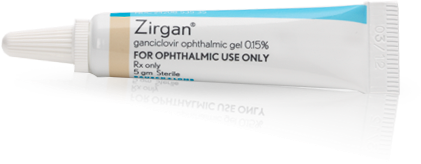 Zirgan Herpes Keratitis Treatment
Zirgan Herpes Keratitis Treatment
Zirgan is the Best Treatment for Herpes Keratitis
(Ganciclovir ophthalmic gel) 0.15% by Bausch & Lomb
The herpes simplex virus (HSV) can attack the eye and result in herpetic keratitis, which is a significant cause of corneal damage that can even lead to blindness. Approximately 50,000 new and recurrent cases of HSV are treated in the United States each year. Herpes simplex keratitis can possibly be very painful and because of this and the extreme damage the virus can cause to the cornea, it is vital to treat the virus with a potent, effective medication to ensure quick resolution of herpetic keratitis and minimize corneal damage and scarring. Untreated herpetic keratitis can result in corneal scarring and loss of visual acuity. Corneal transplants are indicated in those with central scarring that progress to stromal keratitis with severe loss of vision.
keratitis can possibly be very painful and because of this and the extreme damage the virus can cause to the cornea, it is vital to treat the virus with a potent, effective medication to ensure quick resolution of herpetic keratitis and minimize corneal damage and scarring. Untreated herpetic keratitis can result in corneal scarring and loss of visual acuity. Corneal transplants are indicated in those with central scarring that progress to stromal keratitis with severe loss of vision.
Zirgan is a Unique Anti-viral Medicine
Zirgan (ganciclovir 0.5%) is the first innovation in ocular anti-viral therapy in the U.S. since the 1970's. Unlike older anti-viral pharmaceuticals such as Viroptic (trifluridine), which is known to be toxic to the cells of the eye and Acyclovir ointment that affect both healthy and infected corneal cells, Zirgan selectively targets the replication of HSV DNA. Therefore, it leaves normal cornea cells intact and has a low corneal toxicity profile. This provides the patient with more instant relief, less discomfort and better prognosis of the overall corneal health.
How to Use Zirgan
Zirgan is for topical ophthalmic use only. The recommended dosing for Zirgan is one drop five times per day until the corneal ulcer heals (usually about 7-8 days), and then one drop three times per day for seven days. In addition to Zirgan applied to the eye, the patient is often treated with high doses of oral Valtrex or acyclovir.
Adverse Reactions When Using Zirgan
The most common adverse reactions reported in patients using Zirgan are blurred vision (60%), eye irritation (20%), punctate keratitis (5%) and conjunctival hyperemia (redness)(5%).
How Zirgan Works
Zirgan is a prodrug, which means it is given in an inactive form and is then activated inside the body’s cells. Zirgan becomes active inside cells infected by HSV. After zirgan is activated it slows viral replication and also directly embeds into the virus’ DNA chain and stops replication.
Zirgan is the drug of choice for the treatment of ocular herpetic infections because of its safety, effectiveness and tolerability by the patient.

